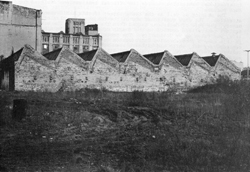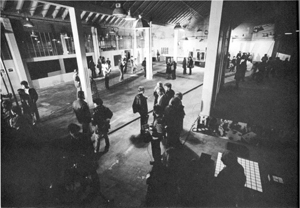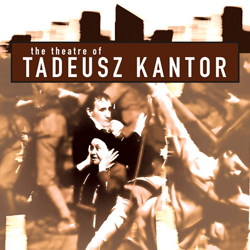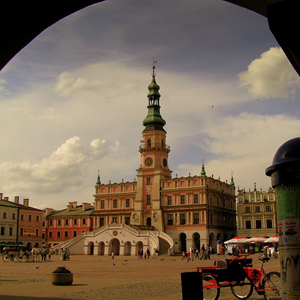This September, Piotrkowska Street in Łódź will be overtaken by contemporary artists participating in the interdisciplinary exhibition Fokus Łódź Biennale 2010. Responding to the social specificity of the public space, the third Biennale (previous iterations took place in 2004 and 2006), entitled From the Liberty Square to the Independence Square, will include works of art created by invited national and international artists during the preceding workshop days. Since its inception, the main objective of the Biennale has been the artistic education of the local community through the introduction of contemporary art to a wide audience. The nourishing of site-specific work, international exchange, and public outreach originates from further back in the artistic circles of Łódź than the inaugural event in 2004, however.
In 1981, Polish artist Ryszard Waśko, with several collaborators, organized the exhibition Construction in Process. The show brought together work by 54 international artists in an abandoned 19th century textile factory. Continued in later years in various locations throughout Poland and abroad, Construction in Process became a well-known event that led directly to the creation of the Łódź Biennale. Remarkably, that first iteration in 1981 was made possible largely by the local chapter of the Solidarity union, when workers and students were convinced by the artists that the expression of freedom of speech-in this case, through Minimal and Process Art-would strengthen their common political goals.
 Solidarity provided the exhibition space, raw materials, and tools, and even manufactured some of the artworks. To prepare the hall, an out-of-use factory on then-PKWN Street, Waśko engaged volunteers and students from the film school, where he taught. They carried out literally tons of abandoned spare parts and scraps, and scrubbed the floors. Finding inconspicuous means of disposing the scrap metal, Waśko recalled, was one of the greatest challenges of the early planning stages. Resourcefulness was indispensible at every point in the creation of Construction in Process. Thinking back to those difficult times, Waśko characterized the experience as if he were undertaking the organization of an art exhibition “on the moon.”
Solidarity provided the exhibition space, raw materials, and tools, and even manufactured some of the artworks. To prepare the hall, an out-of-use factory on then-PKWN Street, Waśko engaged volunteers and students from the film school, where he taught. They carried out literally tons of abandoned spare parts and scraps, and scrubbed the floors. Finding inconspicuous means of disposing the scrap metal, Waśko recalled, was one of the greatest challenges of the early planning stages. Resourcefulness was indispensible at every point in the creation of Construction in Process. Thinking back to those difficult times, Waśko characterized the experience as if he were undertaking the organization of an art exhibition “on the moon.”
 What they created was a curious, multilayered exhibition-only possible in this place and at this specific moment in history-that embodied unresolved politics, Minimal aesthetics, and a bohemian approach to life and art that looked back to the 1930s avant-garde artists. The exhibition not only rejected the political bodies in power at the time, but attempted to propose an altogether new social and political reality.
What they created was a curious, multilayered exhibition-only possible in this place and at this specific moment in history-that embodied unresolved politics, Minimal aesthetics, and a bohemian approach to life and art that looked back to the 1930s avant-garde artists. The exhibition not only rejected the political bodies in power at the time, but attempted to propose an altogether new social and political reality.
Founded in Gdańsk in 1980 by shipyard workers, Solidarity was the first non-State-controlled workers’ trade union in any Soviet bloc country, and it was rapidly gaining members and momentum throughout Poland. The non-violent and anti-bureaucratic visions of the group, which had started with the local, working class concerns of Gdańsk, immediately resonated with a much broader population. Citizens of various social and educational backgrounds, including factory workers, academics, and artists, came together to create one extraordinary force. The political convictions of the members were similarly varied, a circumstance seldom remembered in contemporary politics; conservatives and liberals found support in one another against the ruling government, in effect a common enemy. In a collaboration that might seem remarkable today, the pro-democracy Solidarity workers of Łódź enabled the exhibition of work by local and international bohemian leftist artists. Among these, for instance, was the American artist Carl Andre, an ardent, published, and well-known Communist.
 Many of the Polish participants, the so-called neo-avant-garde, similarly identified with progressive movements. They looked back to the Polish Constructivists such as Katarzyna Kobro, who along with her husband Władysław Strzemiński, was part of the artistic circle grupa a.r. The a.r. group embodied many of the contemporaneous European values grounded in political and social idealism, secularism, and internationalism. Bringing Russian Constructivism to Łódź, they were locally active in the 1920s and ‘30s. Led primarily by Strzemiński (along with the considerable engagement of Kobro and Henryk Stażewski), the a.r. group set about amassing a collection of work by Polish and other European modern artists, including pieces representing Cubism, Dadaism, Futurism, Constructivism, and Surrealism. The considerable collection of artwork by international avant-gardes, among the first and largest in the world, would define the character of Muzeum Sztuki to the present.
Many of the Polish participants, the so-called neo-avant-garde, similarly identified with progressive movements. They looked back to the Polish Constructivists such as Katarzyna Kobro, who along with her husband Władysław Strzemiński, was part of the artistic circle grupa a.r. The a.r. group embodied many of the contemporaneous European values grounded in political and social idealism, secularism, and internationalism. Bringing Russian Constructivism to Łódź, they were locally active in the 1920s and ‘30s. Led primarily by Strzemiński (along with the considerable engagement of Kobro and Henryk Stażewski), the a.r. group set about amassing a collection of work by Polish and other European modern artists, including pieces representing Cubism, Dadaism, Futurism, Constructivism, and Surrealism. The considerable collection of artwork by international avant-gardes, among the first and largest in the world, would define the character of Muzeum Sztuki to the present.
The values propagated by the artists of grupa a.r.-their deep beliefs in collectivity, internationalism, the possibility for a better society through art, and their commitment to educating the public-were all convictions passed down to the organizers of Construction in Process and now influences the mission of the Łódź Biennale. For now, we’re left to see how these values will manifest in this year’s events.
Fokus Łódź Biennale 2010: From the Liberty Square to the Independence Square will take place in Łódź from September 11 to October 10, 2010. It is being organized by Muzeum Miasta Łodzi, under the direction of Ryszard Waśko, curatorial team Sabine Russ and Gregory Volk, and selection committee comprised of Mirosław Bałka, Gabriele Horn, Hans Ulrich Obrist, Angelika Stepkan, Jarosław Suchan, and Richard Vine. The 60 participating artists include Yael Bartana, Cezary Bodzianowski, Tacita Dean, Luc Tuymans, and Clemens von Wedemeyer. More information about the event and participating artists is available online at www.biennalelodz.pl.
Konstrukcja w Procesie / Construction in Process took place in Łódź from October 26 to November 15, 1981.
More information about Muzeum Sztuki w Łodzi and its founding collection, The International Collection of Modern Art in Łódź, is available on the Muzeum Sztuki website at msl.org.pl.
CR
Imagery
- Budrem factory building at ul. PKWN 37, to which Solidarity gave access to artist organizers for the first Construction in Process in 1981. Photo courtesy of Ryszard Wasko.
- Installation view of Construction in Process during the opening reception. Here, works by Ryszard Winiarski, Richard Nonas, Fred Sandback, and Peter Downsbrough. Photo courtesy of Ryszard Wasko.
- The International Collection of Modern Art in Lodz was the founding collection of Muzeum Sztuki w Lodzi in 1932. Image courtesy of the Muzeum Sztuki website msl.org.pl.



